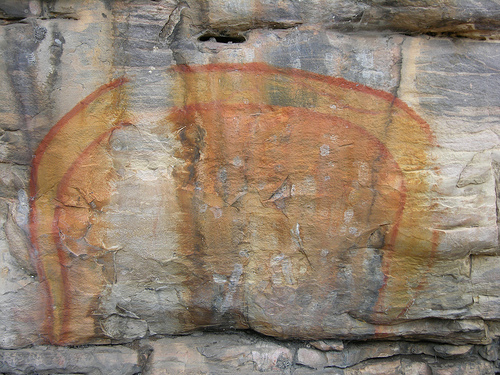HSS @Elmira College
Snake

Rainbow Serpent
Monday, June 24, 2013
Tuesday, June 11, 2013
Prisonation: Visions of California in the 21st Century
A series of landscape paintings and prints depicting all of California's thirty-three state prisons, inspired by paintings of the American West from the 19th century.
The entire series was exhibited at the Santa Barbara Contemporary Arts Forum in 2001.
A book has been published about the project: "Incarcerated: Visions of California in the 21st Century." A similar series was completed in 2002, depicting all fifteen of New York State's maximum security correctional facilities and exhibited at Debs & Co. Gallery, NYC, in a show entitled
"Maximum Security: Visions of New York in the 21st Century".
Carceral Geography Blog
- TN
Monday, June 10, 2013
Big Plans!
I always begin the summer with big plans: I'm going to turn a couple of conference papers into articles, dust of a book proposal that I began working on a couple years ago, actually get on top of courses for the year, read books that I don't have time to read during the academic year, etc., etc. Typically, I complete a fraction of this work due to the various other obligations I have: summer teaching, family obligations, the list of home repairs that is at least as ambitious as my various scholarly plans. I never finish any of the lists, although I do make a dent in all them. I've learned to be relatively upbeat about this sorry state of affairs; after all, our plans really don't amount to all that much in the grand scheme of things. Maybe I'll put "enjoy the summer" at the top of all my various lists.
Wednesday, May 15, 2013
Secrets (Plant-to-Plant)
* A new paper in Ecology Letters titled "Underground signals carried through common mycelial networks warn neighbouring plants of aphid attack" (2013) suggests that bean plants can signal other plants (through mycorrhizal fungi which colonize their roots) to produce aphid-repellent chemicals when aphids are in the area. These chemicals also attract parasitoids that eat the aphids.
* I'll leave the sticky plant ethics to Corey, but the bean plant-on-bean plant dynamic raises a few other interesting issues.
* If we consider this signaling through fungi a form of communication between plants, does it shift our conception of communication? Does it change how we see vegetables, minerals, animals? How can plant-to-plant gossip reorient our vision of "Nature," what is "natural" and how material -- living and nonliving -- acts? And what about the attracted parasitoids? Is there such a thing as truly ecological material poetics? Fungi/form/message? The aesthetics of bean talk? Things are getting crazy...
* A few thoughts: “… the image of dead or thoroughly instrumentalized matter feeds human hubris and our earth-destroying fantasies of conquest and consumption… by preventing us from detecting (Seeing, hearing, smelling, tasting, feeling) a fuller range of the nonhuman powers circulating around and within human bodies” (Jane Bennett, Vibrant Matter ix).
* “There is no object, no subject… But there are events. I never act; I am always slightly surprised by what I do” (Bruno Latour, Pandora’s Hope 281).
* “The basic dualism in the world lies not between spirit and nature, or phenomenon and noumenon, but between things in their intimate reality and things as confronted by other things” (Graham Harman, Guerrilla Metaphysics 74).
-- TN
Tuesday, April 23, 2013
University of Illinois to hire 500 New Faculty and Increase Funding for Humanities and Social Science by 50%
Good news for Humanities and Social Science disciplines here.
Reading the news report, I was interested in how such an outlay of resources would be justified by Chancellor Wise:
1. These fields contribute to the quality of life of not just the individuals who get these degrees but also the people in their community.
2. The skills students in these programs will acquire skills that will make them more adaptable to an ever-changing work environment.
Obviously, there must be studies to support both of these claims; is anyone aware of any good ones?
Via Leiter.
Reading the news report, I was interested in how such an outlay of resources would be justified by Chancellor Wise:
“In 20 to 50 years, there will be fewer great research universities than there are today,” Wise said. “I believe that the ones that will survive and thrive are the ones that embrace and manage change. They are the ones where excellence is both broad and deep. They are the ones that will be relevant to society, that will add value to the people who are paying for that education. They will be the ones that contribute to the quality of life of the citizens around them, and they will be the ones that perceive the sense of urgency, that are agile enough to embrace change and not be managed by the changes.”I'm assuming that 500 faculty lines won't be added in these disciplines, but the article is a bit unclear on that. Still, it's good news. It seems that the reasons that she gives boil down to two:
1. These fields contribute to the quality of life of not just the individuals who get these degrees but also the people in their community.
2. The skills students in these programs will acquire skills that will make them more adaptable to an ever-changing work environment.
Obviously, there must be studies to support both of these claims; is anyone aware of any good ones?
Via Leiter.
Subscribe to:
Posts (Atom)

